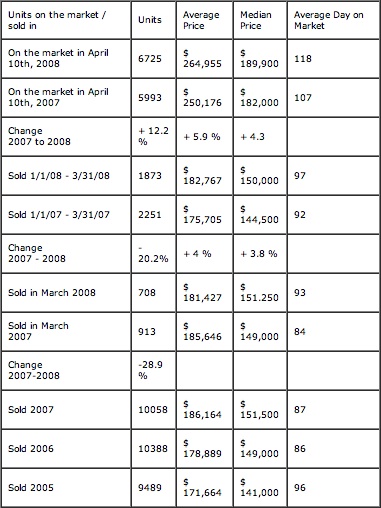Teaching:TUW - UE InfoVis WS 2009/10 - Gruppe 06 - Aufgabe 2
Aufgabenstellung
Zu beurteilende Tabelle
Critique about the table
- The grid encloses the entire table. This should be avoided, because it breaks up the data. (Use white spaces or rules under the header and over the footer instead) (Page 136).
- Time based data should be arranged in columns from left to right rather than in rows from top to bottom (Page 142).
- Groups and Breaks: All the content is put in one table. Split the table instead in all the data groups that belong together (Page 143).
- No whitespacing between different groups of the table (Page 144).
- Headers are not repeated over the different group sections (Page 144).
- Text align of numbers should not be aligned to the left side (Page 147).
- Number format is not consistent: Column "Median Price" uses two different formats (Sold in March 2007 vs. Sold in March 2008: Thousand sepatator is once a point and once a comma). Column 1 ("Units") doesn't use any separators at all (Page 149).
- $ sign is not necessary in every cell.
- difficult formulations: 1/1/08 - 3/31/08 instead of 1st Quartal 2008
- The change rows shouldn't be in the same columns because they do not even have the same measurement than the other columns.
- Different meanings in the same column. For example 4 different Meanings of 'Units':
- Units on the market
- Units sold in one period
- Change of Units on the market between to periods
- Change of Units sold between two periods
- 'Average Day on the market' is illogical in context of a defined period
[2004, Few] Stephen Few, Show Me the Numbers: Designing Tables and Graphs to Enlighten, Analytics Press, 2004, Chapter 8 - Table Design.
New Table
Critique about the new table:
- the currency is missing
- no whitespace between the rows
- i would split up the table into 'on the market' and 'sold in' because there is no apparent relation between their rows
- What does 'Average Day on Market' means in the context of sold in / or units on the market

